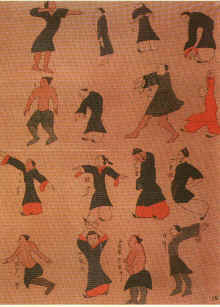Back | Taiji Quan | Bagua Zhang | Xingyi Quan | Tongbei Quan | EIGCT | Basic Gongfu | Qigong | Others
| During several thousand years of development, there are many different
Qigong skills in China. Qi is a special item in traditional Chinese culture. Qigong is a
practice of controlling and moving Qi and making the Qi stronger. Thereby, Qigong will
help people to increate physical ability and self control ability. As a result, Qigong
practice can produce good health and long life. In traditional Chinese martial arts,
combining both martial skills and Qigong practice is common. Practicing Qigong can also
help to increase your internal force and enhance your application skills. All high level
styles include both. It is said "if you only practice martial skill without Qigong,
when you get older, you have nothing". On the other hand, the most important thing in
Qigong practice is to develop your personality, develop your moral integrity, and
understand your life lessons. Only practicing in this way does your health and skills mean
something. It is called "Nei Wai Jian Gu, Xing Ming Shuang Xiu" (To practice
both internal and external kungfu, and develop both health and personality).
There are three main categories of many different styles of Qigong practice. They are Taoist Qigong, Buddhist Qigong, and Confucianist Qigong. In each of them, there are many branches and variations. The main practice in YCGF is Taoist Quanzheng (Complete Truth) Longmen (Dragon Gate) Style. In this style, we respect Taoist immortal Lu Dongbing (Chuanyangzi) as the ancestor of the group. Taoist Master Wang Chongyang (1112 - 1170) studied Lu's idea and then founded the Quanzheng group. Wang had seven disciples and each one created his own branch. Qiu Chuji (Changchuanzi) was the most famous of them. His branch is called Longmen. Because of his high level skills, the emperor Gengiskhan was very respectful to him. His group became very famous and popular. Grand Master Wang Peisheng studied Buddhist Qigong with Liaoyi and Miaochan when he was thirteen. Then he studied Taoist Qigong with Shen Xinchuan and Wu Jinyong, and Confucianist Qigong with Jin Hu and Xu Zhenkuan. All these studies and practices allowed him not only to understand Qigong but also philosophy. Grand Master Wang and some famous masters, like Wang Daoyi, Wang Wanfang, Sun Xikun, etc, were good friends and also did a lot of research of Qigong practice together. Today Grand Master Wang is already more than Eighty years old. His body is still in very good condition. He has a very busy schedule teaching Qigong and martial arts. He can still fight with younger men. Only from watching what he can do, can we know how about his level. Because Qigong is a complex and difficult discipline, sometimes even dangerous, practitioners should be very careful. Usually if one cannot be with his master very often, we suggest that he does not undergo special practice. All three internal gongfu, Taiji, Bagua, and Xingyi, include Qigong practice in their training. If you can practice them correctly, you can also reach a high level of Qigong study. The benefit of this way is safety. The Qigong practice which we practice and teach in YCGFA-NAH include: Health and Healing Simple Methods: It includes about one hundred short exercise routines for practice. Xing Ming Shuangxiu Fajue: It is a high level Qigong practice in Longmen Style. It includes Zhuji Gong (basic gongfu), Xiaozhoutian (microcosmic), Dazhoutian (macrocosmic), and five step processes. Qiankun Wuji Gong: It is a complex system which was founded by Grand Master Wang. He learned some useful and efficient methods from different styles and made this new system. This synthetic practice can allow practitioners study Qigong and martial arts skills quickly. |
|
 Part of "Qigong Practice" slik painting unearthed from Han Dynasty (206 - 24 B. C.) tombs at Mawangdui.
|
Back | Taiji Quan | Bagua Zhang | Xingyi Quan | Tongbei Quan | EIGCT | Basic Gongfu | Qigong | Others





